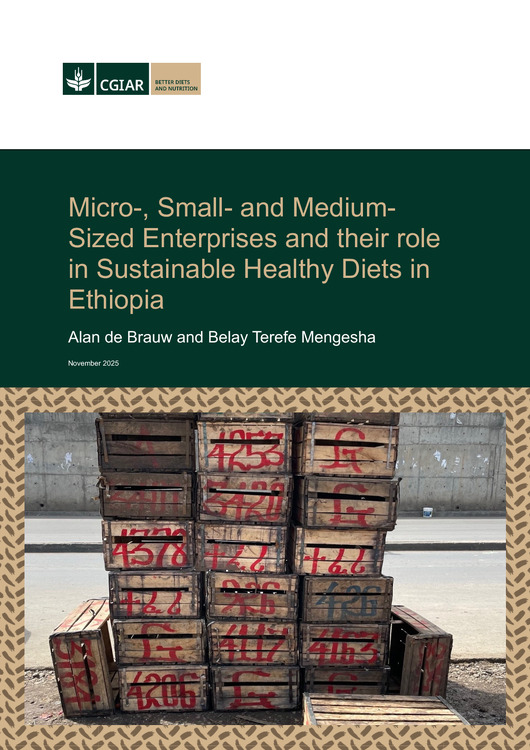
Brief
Micro-, small- and medium-sized enterprises and their role in sustainable healthy diets in Ethiopia
2025de Brauw, Alan; Mengesha, Belay Terefe
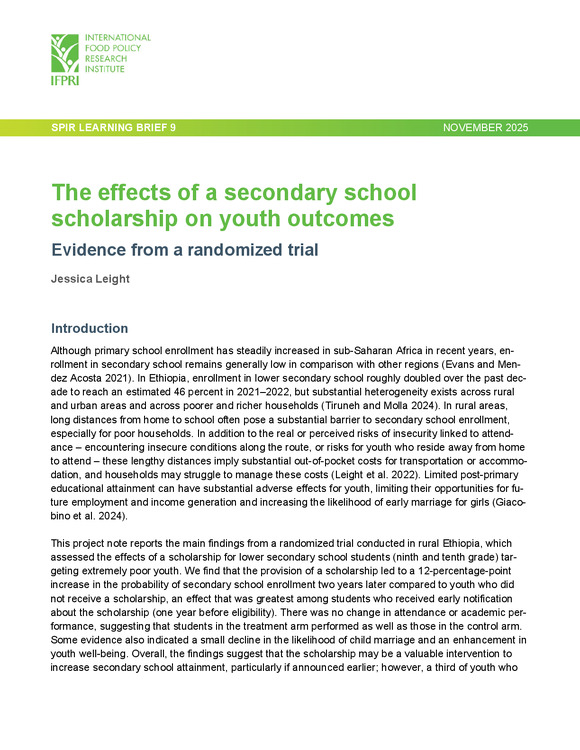
Brief
The effects of a secondary school scholarship on youth outcomes: Evidence from a randomized trial
2025Leight, Jessica
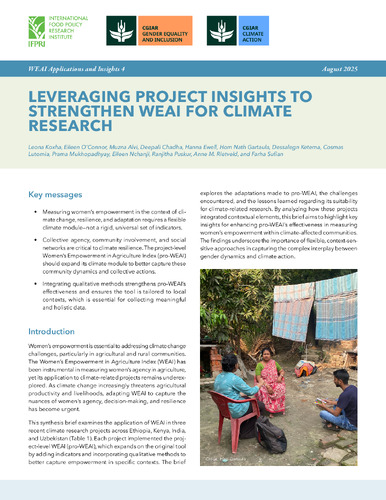
Brief
Leveraging project insights to strengthen WEAI for climate research
2025
...more
Puskur, Ranjitha; Rietveld, Anne M.; Sufian, Farha
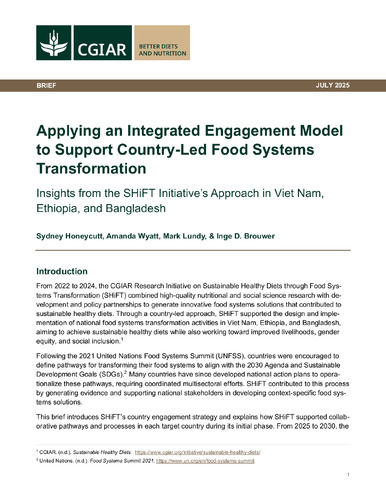
Brief
Applying an integrated engagement model to support country-led food systems transformation: Insights from the SHiFT Initiative's approach in Viet Nam, Ethiopia, and Bangladesh
2025Honeycutt, Sydney; Wyatt, Amanda; Lundy, Mark; Brouwer, Inge D.
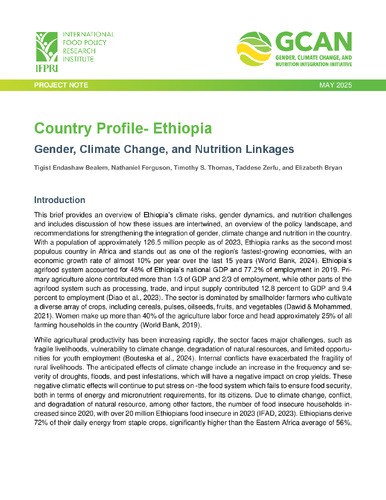
Brief
Country profile – Ethiopia: Gender, climate change, and nutrition linkages
2025Bealem, Tigist Endashaw; Ferguson, Nathaniel; Thomas, Timothy S.; Zerfu, Taddese Alemu; Bryan, Elizabeth

Brief
Ethiopia: Cost effective options for inclusive and sustainable development
2025Aragie, Emerta A.; Thurlow, James; Taffesse, Alemayehu Seyoum; Pauw, Karl; Jones, Eleanor
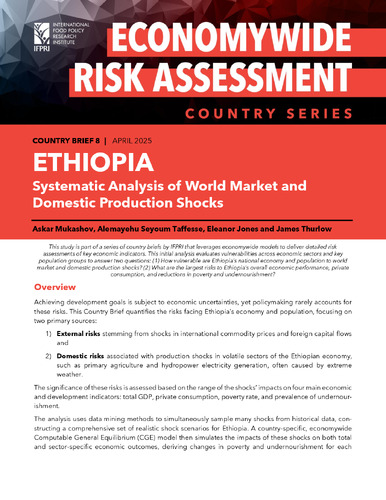
Brief
Ethiopia: Systematic analysis of world market and domestic production shocks
2025Mukashov, Askar; Taffesse, Alemayehu Seyoum; Jones, Eleanor; Thurlow, James

Brief
Development of the rural household energy insecurity experiences scale with insights from Ethiopia
2024Arega, Tiruwork; Ringler, Claudia
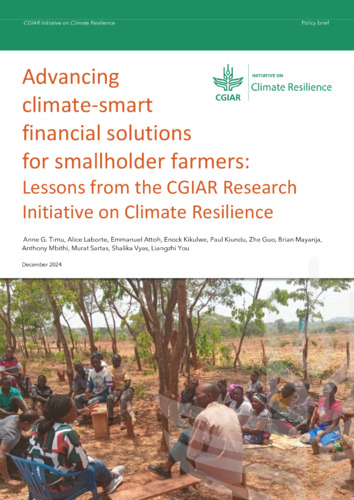
Brief
Advancing climate-smart financial solutions for smallholder farmers: Lessons from the CGIAR Climate Resilience Initiative
2024
...more
You, Liangzhi

Brief
Can social assistance reduce violent conflict and civil unrest? Evidence from a large-scale public works program in Ethiopia
2024Hirvonen, Kalle; Machado, Elia; Simons, Andrew M.
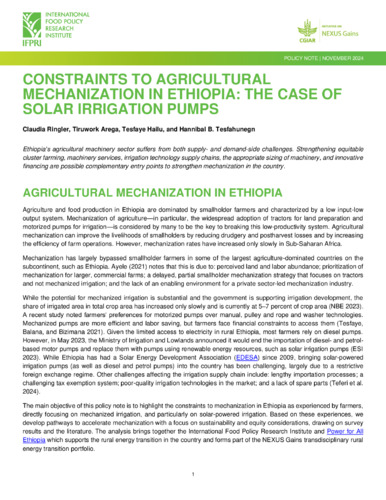
Brief
Constraints to agricultural mechanization in Ethiopia: The case of solar irrigation pumps
2024Ringler, Claudia; Arega, Tiruwork; Hailu, Tesfaye; Tesfahunegn, Hannibal B.
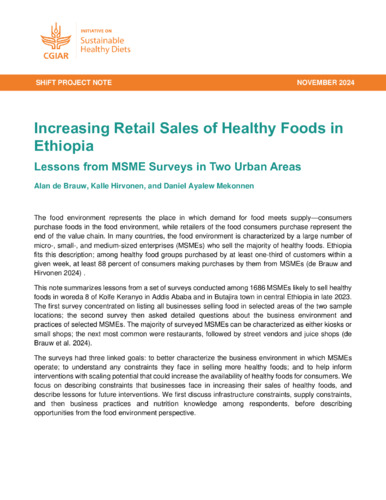
Brief
Increasing retail sales of healthy foods in Ethiopia: Lessons from MSME surveys in two urban areas
2024de Brauw, Alan; Hirvonen, Kalle; Mekonnen, Daniel Ayalew
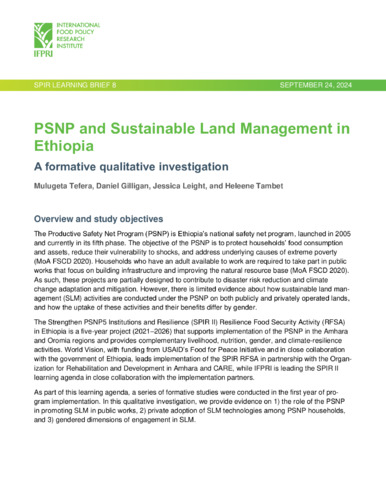
Brief
PSNP and sustainable land management in Ethiopia: A formative qualitative investigation
2024Tefera, Mulugeta; Gilligan, Daniel O.; Leight, Jessica; Tambet, Heleene
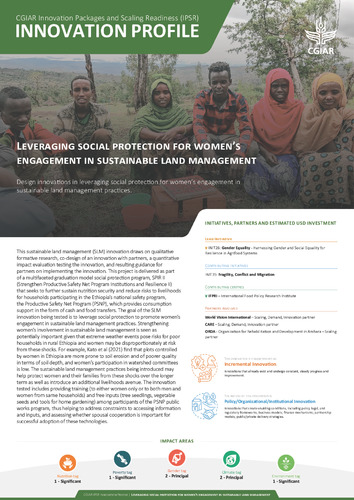
Brief
Leveraging social protection for women’s engagement in sustainable land management: IPSR Innovation Profile. First edition, March 2024
2024Gilligan, Daniel O.; Billings, Lucy; Kalva, Parthu; Leight, Jessica; Tambet, Heleene; Bahiru, Kibret; Mulford, Michael; Bekele, Kalkidan
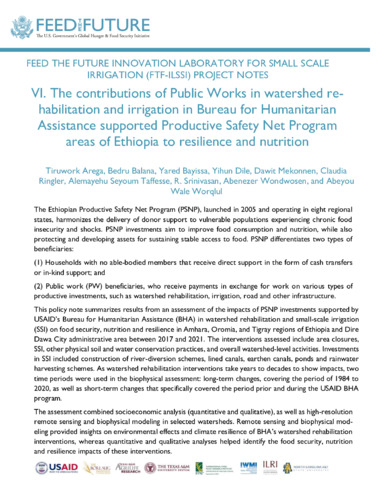
Brief
The contributions of Public Works in watershed rehabilitation and irrigation in Bureau for Humanitarian Assistance supported Productive Safety Net Program areas of Ethiopia to resilience and nutrition
2024Arega, Tiruwork; Balana, Bedru; Bayissa, Yared; Dile, Yihun T.; Mekonnen, Dawit Kelemework; Ringler, Claudia; Taffesse, Alemayehu Seyoum; Srinivasa, R.; Wondwosen, Abenezer; Worqlul, Abeyou Wale
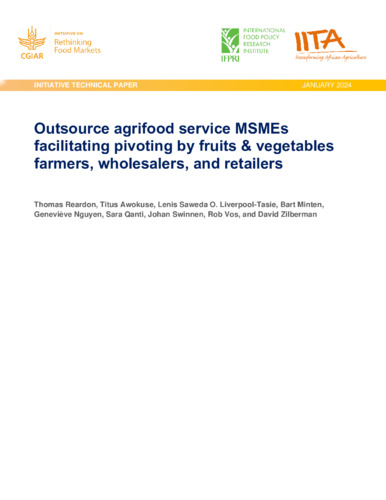
Brief
Outsource agrifood service MSMEs facilitating pivoting by fruits & vegetables farmers, wholesalers, and retailers
2024Reardon, Thomas; Awokuse, Titus; Liverpool-Tasie, Lenis Saweda O.; Minten, Bart; Nguyen, Geneviève; Qanti, Sara; Swinnen, Johan; Vos, Rob; Zilberman, David
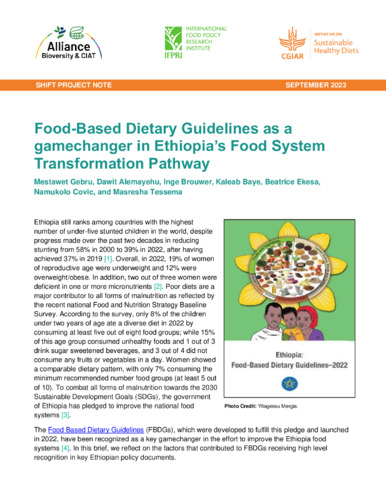
Brief
Food-based dietary guidelines as a gamechanger in Ethiopia’s food system transformation pathway
2023Gebru, Mestawet; Alemayehu, Dawit; Brouwer, Inge D.; Baye, Kaleab; Ekesa, Beatrice; Covic, Namukolo M.; Tessema, Masresha
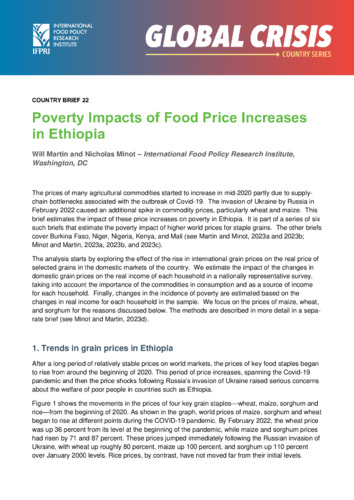
Brief
Poverty impacts of food price increases in Ethiopia
2023Minot, Nicholas; Martin, Will
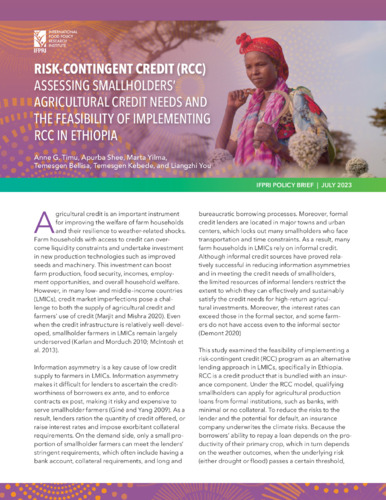
Brief
Risk-Contingent Credit (RCC): Assessing smallholders' agricultural credit needs and the feasibility of implementing RCC in Ethiopia
2023Timu, Anne G.; Shee, Apurba; Yilma, Marta; Bellisa, Temesgen; Kebede, Temesgen; You, Liangzhi
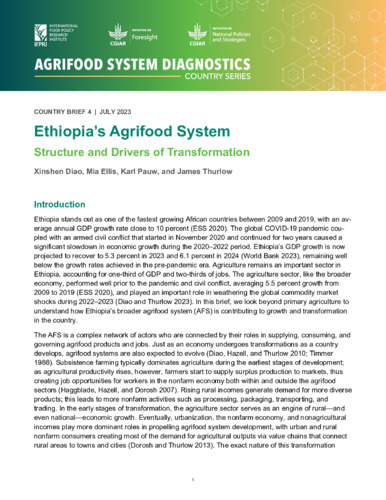
Brief
Ethiopia’s agrifood system structure and drivers of transformation
2023Diao, Xinshen; Pauw, Karl; Thurlow, James; Ellis, Mia
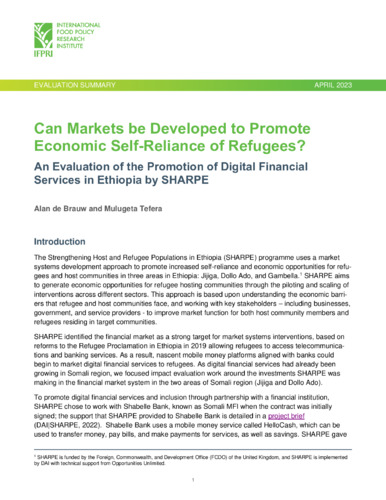
Brief
Can markets be developed to promote economic self-reliance of refugees? An evaluation of the promotion of digital financial services in Ethiopia by SHARPE
2023de Brauw, Alan; Tefera, Mulugeta
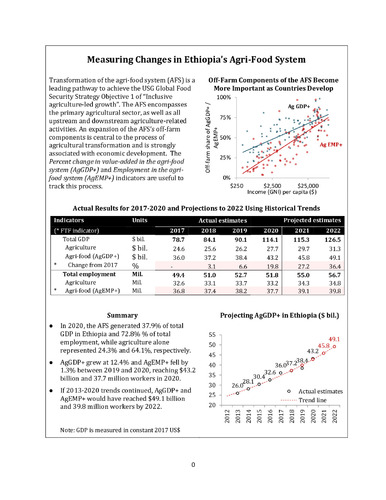
Brief
Measuring changes in Ethiopia’s agri-food system
2023International Food Policy Research Institute; Xinshen Diao; Pauw, Karl; Randriamamonjy, Josee; Thurlow, James
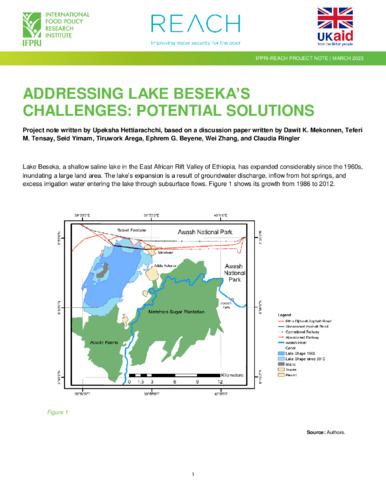
Brief
Addressing Lake Beseka's challenges: Potential solutions
2023Hettiarachchi, Upeksha
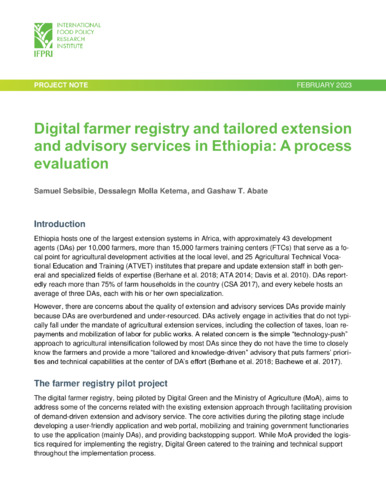
Brief
Digital farmer registry and tailored extension and advisory services in Ethiopia: A process evaluation
2023Sebsibie, Samuel; Ketema, Dessalegn Molla; Abate, Gashaw T.
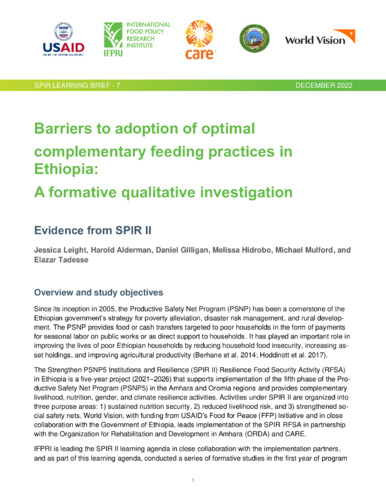
Brief
Barriers to adoption of optimal complementary feeding practices in Ethiopia: A formative qualitative investigation: Evidence from SPIR II
2022Leight, Jessica; Alderman, Harold; Gilligan, Daniel O.; Hidrobo, Melissa; Mulford, Michael; Tadesse, Elazar
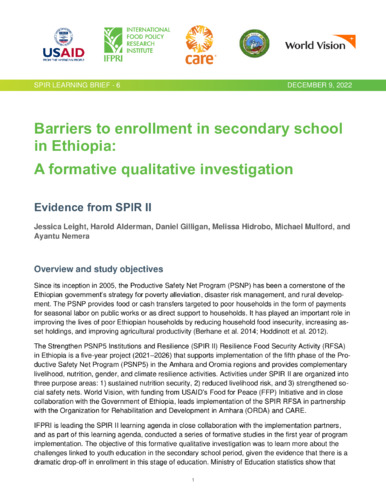
Brief
Barriers to enrollment in secondary school in Ethiopia: A formative qualitative investigation: Evidence from SPIR II
2022Leight, Jessica; Alderman, Harold; Gilligan, Daniel O.; Hidrobo, Melissa; Mulford, Michael; Nemera, Ayantu
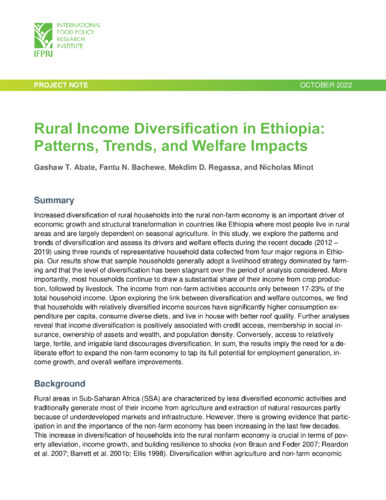
Brief
Rural income diversification in Ethiopia: Patterns, trends, and welfare impacts
2022Abate, Gashaw T.; Bachewe, Fantu Nisrane; Regassa, Mekdim D.; Minot, Nicholas
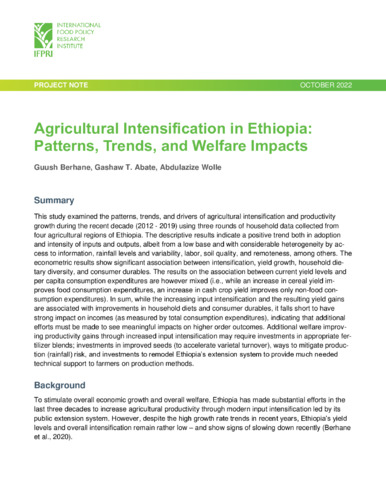
Brief
Agricultural intensification in Ethiopia: Patterns, trends, and welfare impacts
2022Berhane, Guush; Abate, Gashaw T.; Wolle, Abdulazize
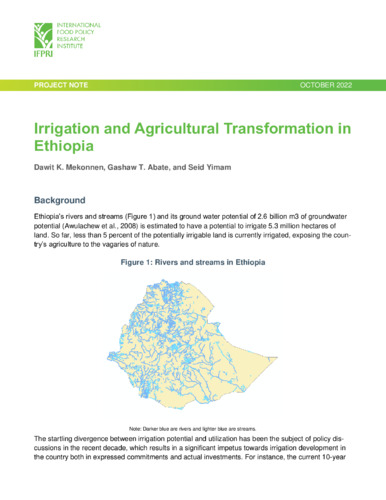
Brief
Irrigation and agricultural transformation in Ethiopia
2022Mekonnen, Dawit Kelemework; Abate, Gashaw T.; Yimam, Seid
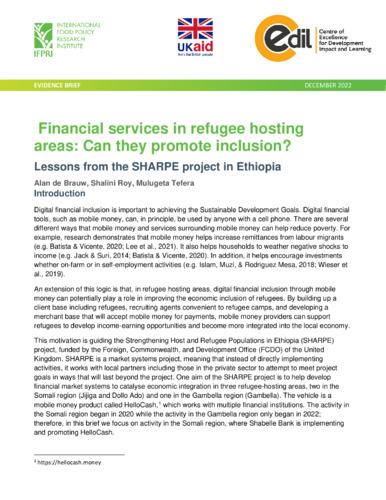
Brief
Financial services in refugee hosting areas: Can they promote inclusion? Lessons from the SHARPE project in Ethiopia
2022de Brauw, Alan; Roy, Shalini; Tefera, Mulugeta

Brief
Energy solutions for irrigation in Ethiopia
2022Xie, Hua; Mekonnen, Dawit Kelemework
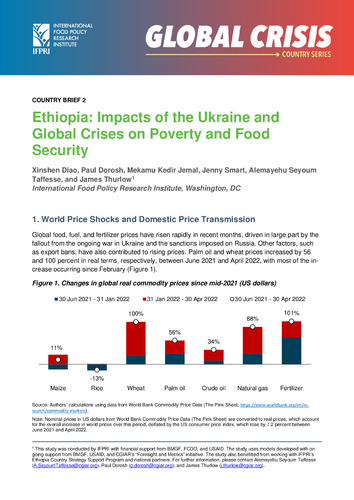
Brief
Ethiopia: Impacts of the Ukraine and global crises on poverty and food security
2022Xinshen Diao; Dorosh, Paul A.; Kedir Jemal, Mekamu; Smart, Jenny; Taffesse, Alemayehu Seyoum; Thurlow, James
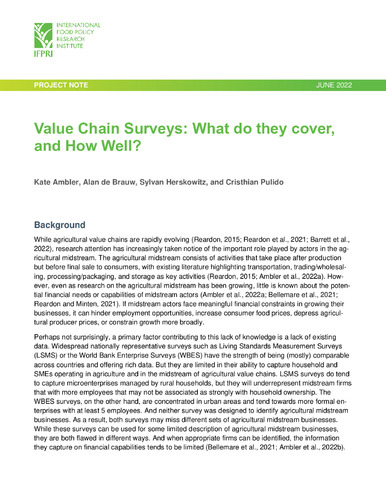
Brief
Value chain surveys: What do they cover, and how well?
2022Ambler, Kate; de Brauw, Alan; Herskowitz, Sylvan; Pulido, Cristhian
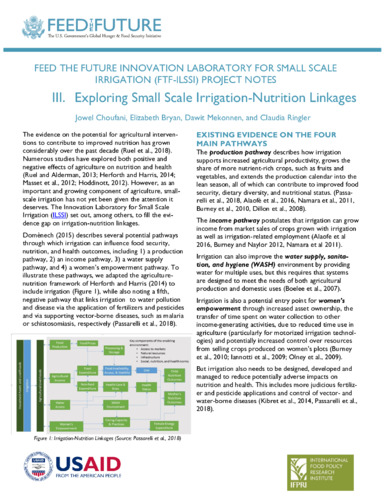
Brief
Exploring small scale irrigation-nutrition linkages
2021Choufani, Jowel; Bryan, Elizabeth; Mekonnen, Dawit Kelemework; Ringler, Claudia
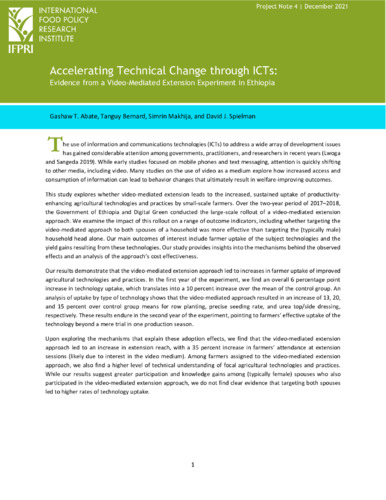
Brief
Accelerating technical change through ICTs: Evidence from a video-mediated extension experiment in Ethiopia
2021Abate, Gashaw T.; Bernard, Tanguy; Makhija, Simrin; Spielman, David J.
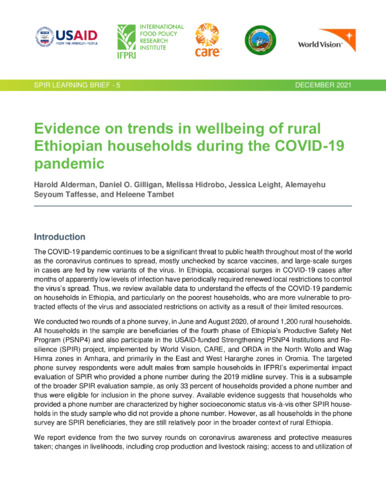
Brief
Evidence on trends in wellbeing of rural Ethiopian households during the COVID-19 pandemic
2021Alderman, Harold; Gilligan, Daniel O.; Hidrobo, Melissa; Leight, Jessica; Taffesse, Alemayehu Seyoum; Tambet, Heleene
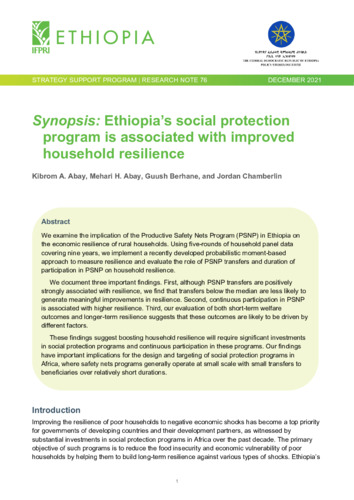
Brief
Synopsis: Ethiopia’s social protection program is associated with improved household resilience
2021Abay, Kibrom A.; Abay, Mehari Hiluf; Berhane, Guush; Chamberlin, Jordan

Brief
Will promotion of agricultural mechanization help prevent child labour?
2021Food and Agricultural Organization of the United Nations; International Food Policy Research Institute; Vos, Rob; Takeshima, Hiroyuki
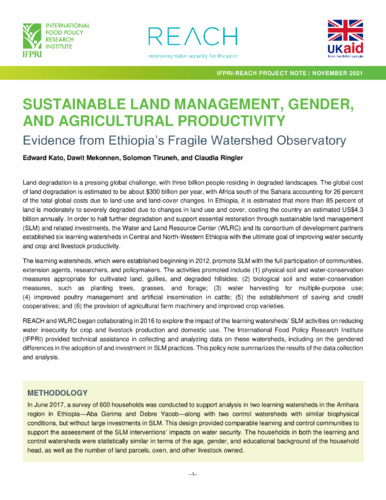
Brief
Sustainable land management, gender, and agricultural productivity: Evidence from Ethiopia's fragile watershed observatory
2021Kato, Edward; Mekonnen, Dawit Kelemework; Tiruneh, Solomon; Ringler, Claudia

Brief
The impact of COVID-19 in Ethiopia: brief
2021Harris, Donna; Baird, Sarah; Ford, Kath; Hirvonen, Kalle; Jones, Nicola
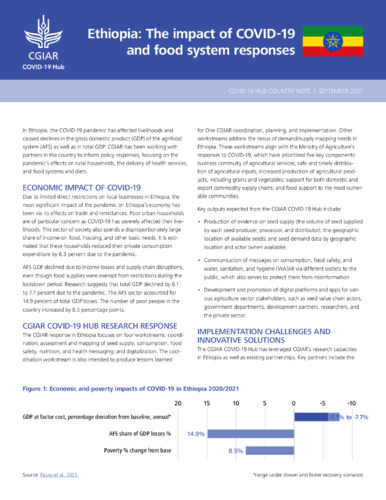
Brief
Ethiopia: The impact of COVID-19 and food system responses
2021COVID-19 Hub
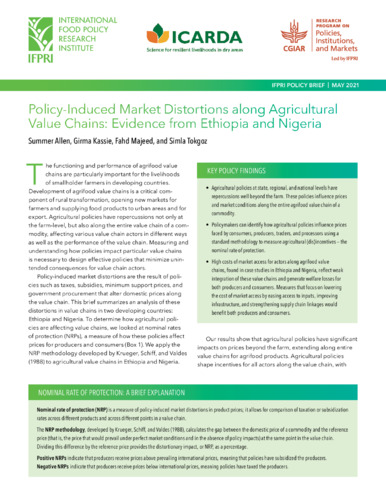
Brief
Policy-induced market distortions along agricultural value chains: Evidence from Ethiopia and Nigeria
2021Allen, Summer L.; Kassie, Girma T.; Majeed, Fahd; Tokgoz, Simla

Brief
Assessing the risk of COVID-19 in Feed the Future countries
2021Koo, Jawoo; Azzarri, Carlo; Ghosh, Aniruddha; Quabili, Wahid
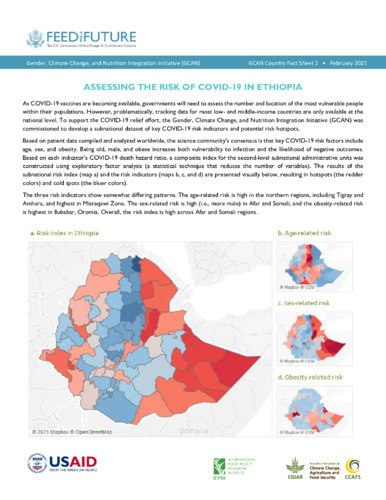
Brief
Assessing the risk of COVID-19 in Ethiopia
2021Koo, Jawoo; Azzarri, Carlo; Ghosh, Aniruddha; Quabili, Wahid
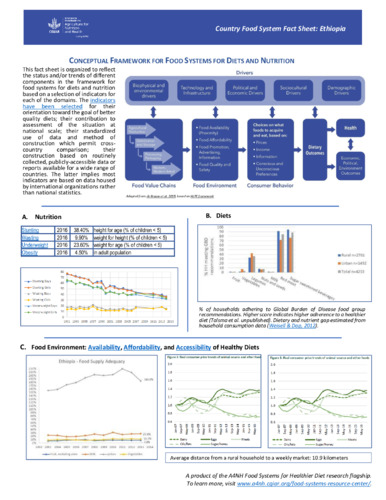
Brief
Conceptual framework for food systems for diets and nutrition: Country food system fact sheet: Ethiopia
2021CGIAR Research Program on Agriculture for Nutrition and Health; Lecoutere, Els; Trijsburg, Laura; Vignola, Raffaele; Mekonnen, Daniel Ayalew
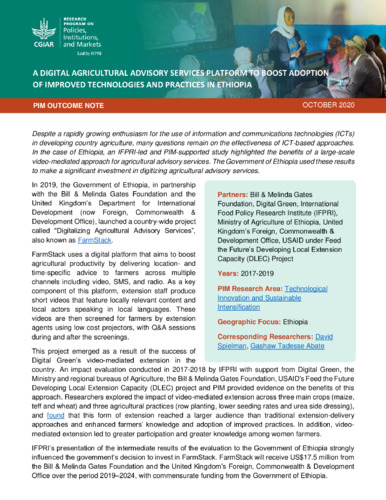
Brief
A digital agricultural advisory services platform to boost adoption of improved technologies and practices in Ethiopia
2020CGIAR Research Program on Policies, Institutions, and Markets; Spielman, David J.; Abate, Gashaw T.
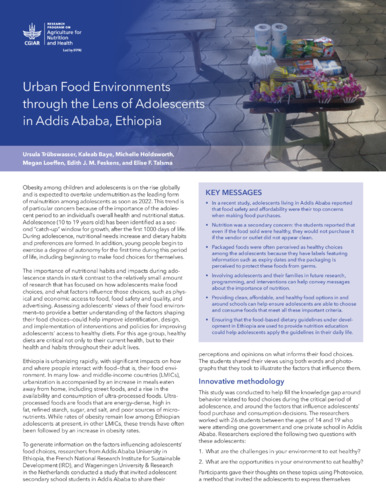
Brief
Urban food environments through the lens of adolescents in Addis Ababa, Ethiopia
2020Trübswasser, Ursula; Baye, Kaleab; Holdsworth, Michelle; Loeffen, Megan; Feskens, Edith J. M.; Talsma, Elise F.
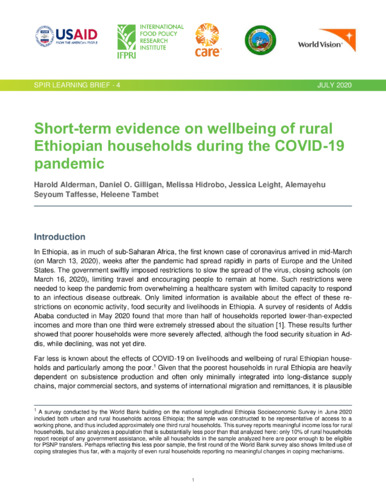
Brief
Short-term evidence on wellbeing of rural Ethiopian households during the COVID-19 pandemic
2020Alderman, Harold; Gilligan, Daniel O.; Hidrobo, Melissa; Leight, Jessica; Taffesse, Alemayehu Seyoum; Tambet, Heleene

Brief
Capturing the productive use dividend: Valuing the synergies between rural electrification and smallholder agriculture in Ethiopia
2020Borgstein, Edward; Mekonnen, Dawit Kelemework; Wade, Kester; Anchala, Chimdo; Elisha, Francis; Eshetu, Yiheyis; Ernst, Kendall; Santana, Scarlett; Teshome, Kebede
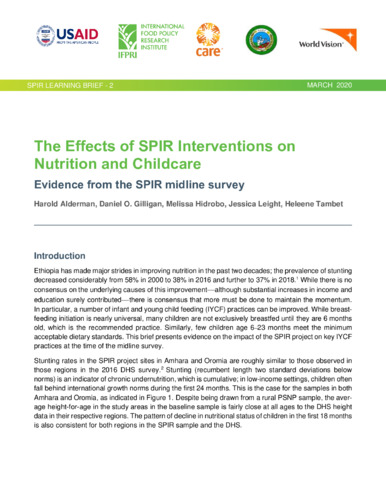
Brief
The effects of SPIR Interventions on nutrition and childcare: Evidence from the SPIR midline survey
2020Alderman, Harold; Gilligan, Daniel O.; Hidrobo, Melissa; Leight, Jessica; Tambet, Heleene
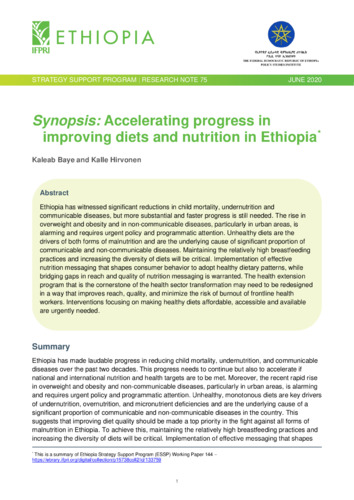
Brief
Synopsis: Accelerating progress in improving diets and nutrition in Ethiopia
2020Baye, Kaleab; Hirvonen, Kalle
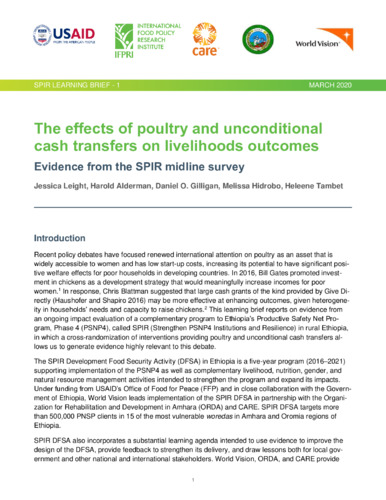
Brief
The effects of poultry and unconditional cash transfers on livelihoods outcomes: Evidence from the SPIR midline survey
2020Leight, Jessica; Alderman, Harold; Gilligan, Daniel O.; Hidrobo, Melissa; Tambet, Heleene
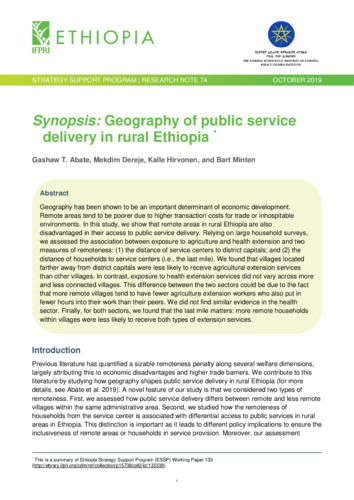
Brief
Synopsis: Geography of public service delivery in rural Ethiopia
2019Abate, Gashaw T.; Dereje, Mekdim; Hirvonen, Kalle; Minten, Bart

Brief
Rising cereal prices in Ethiopia: An assessment and possible contributing factors
2019Minten, Bart; Dorosh, Paul A.

Brief
Promoting fruit and vegetable intake in urban Ethiopia: An experiment using video-based communication
2019Abate, Gashaw T.; Baye, Kaleab; de Brauw, Alan; Hirvonen, Kalle
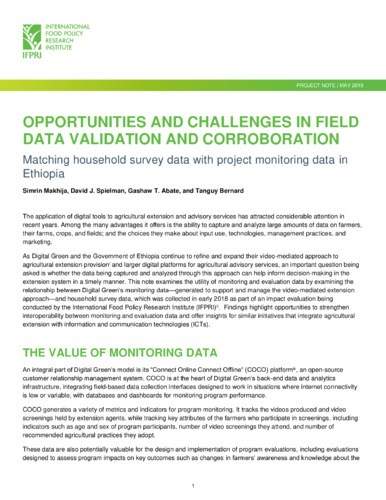
Brief
Opportunities and challenges in field data validation and corroboration: Matching household survey data with project monitoring data in Ethiopia
2019Makhija, Simrin; Spielman, David J.; Abate, Gashaw T.; Bernard, Tanguy
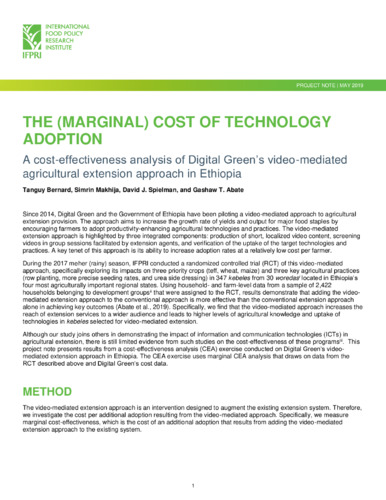
Brief
The (marginal) cost of technology adoption: A cost-effectiveness analysis of Digital Green’s video-mediated agricultural extension approach in Ethiopia
2019Bernard, Tanguy; Makhija, Simrin; Spielman, David J.; Abate, Gashaw T.
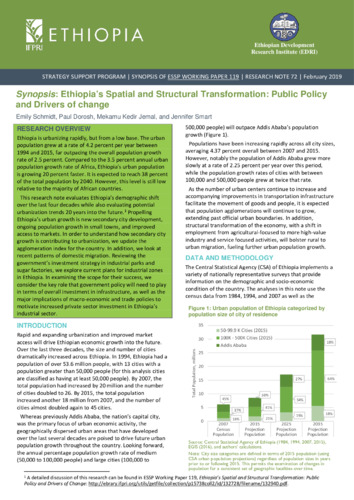
Brief
Synopsis: Ethiopia's spatial and structural transformation: Public policy and drivers of change
2019Schmidt, Emily; Dorosh, Paul A.; Kedir Jemal, Mekamu; Smart, Jenny
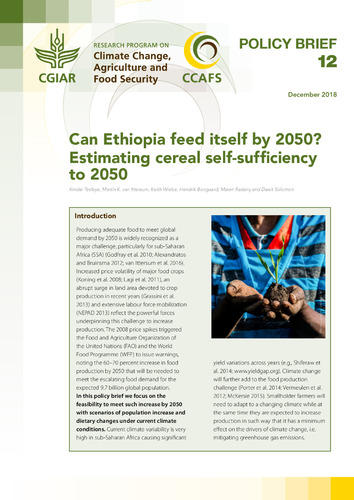
Brief
Can Ethiopia feed itself by 2050? Estimating cereal self-sufficiency to 2050
2018Tesfaye, Kindie; Ittersum, Martin K. van; Wiebe, Keith D.; Boogaard, Hendrik L.; Radeny, Maren A.O.; Solomon, Dawit
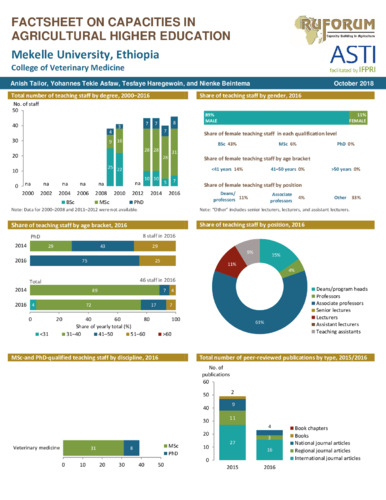
Brief
Factsheet on capacities in agricultural higher education: Mekelle University, Ethiopia College of Veterinary Medicine
2018Tailor, Anish; Asfaw, Yohannes Tekle; Haregewoin, Tesfaye; Beintema, Nienke M.
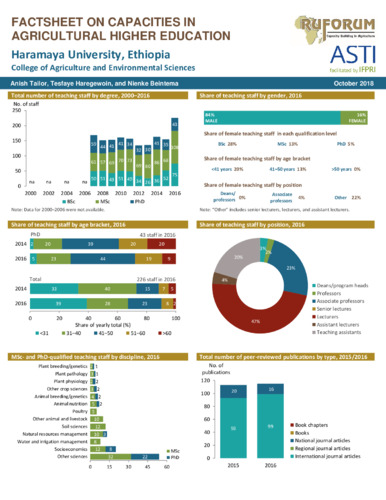
Brief
Factsheet on capacities in agricultural higher education: Haramaya University, Ethiopia College of Agriculture and Environmental Sciences
2018Tailor, Anish; Haregewoin, Tesfaye; Beintema, Nienke M.
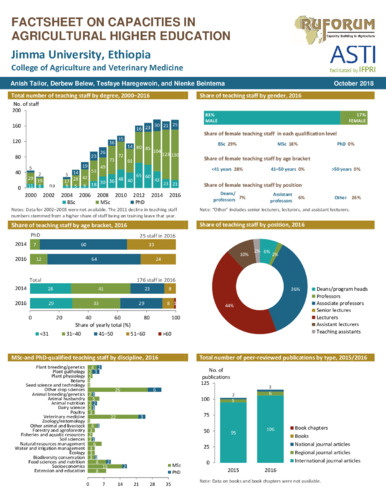
Brief
Factsheet on capacities in agricultural higher education: Jimma University, Ethiopia College of Agriculture and Veterinary Medicine
2018Tailor, Anish; Belew, Cerbew; Haregewoin, Tesfaye; Beintema, Nienke M.
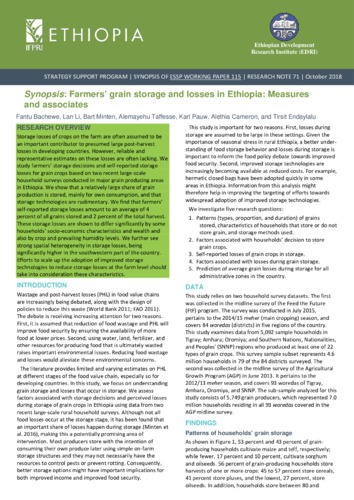
Brief
Synopsis: Farmers’ grain storage and losses in Ethiopia: Measures and associates
2018Bachewe, Fantu Nisrane; Li, Lan; Minten, Bart; Taffesse, Alemayehu Seyoum; Pauw, Karl; Cameron, Alethia; Genye, Tirsit
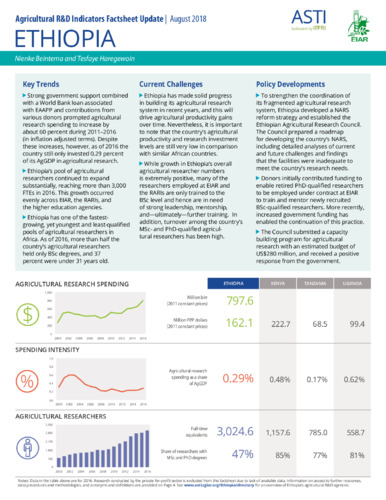
Brief
Ethiopia: Agricultural R&D indicators factsheet update
2018Beintema, Nienke M.; Hailu, Mekonnen; Haregewoin, Tesfaye; Hilegiorgis, Dejene; Rahija, Michael; Bezabeh, Eyob
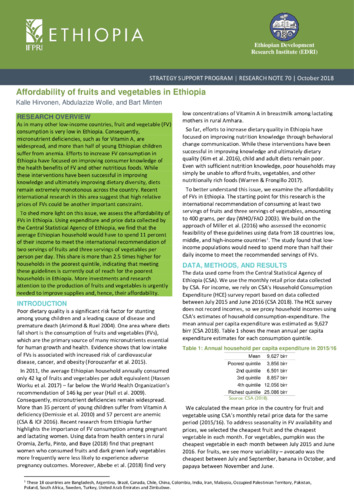
Brief
Affordability of fruits and vegetables in Ethiopia
2018Hirvonen, Kalle; Wolle, Abdulazize; Minten, Bart
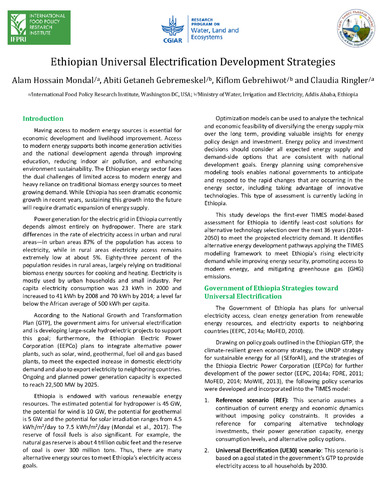
Brief
Ethiopian universal electrification development strategies
2018Mondal, Md. Hossain Alam; Gebremeskel, Abiti Getaneh; Gebrehiwot, Kiflom; Ringler, Claudia
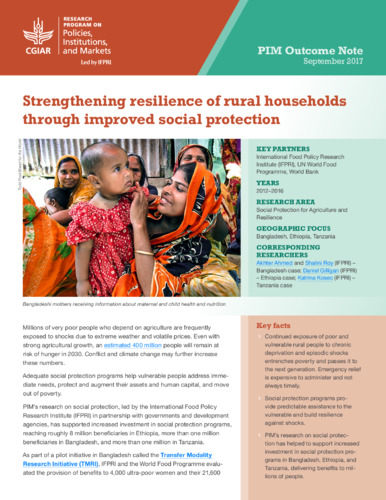
Brief
Strengthening resilience of rural households through improved social protection
2017CGIAR Research Program on Policies, Institutions, and Markets
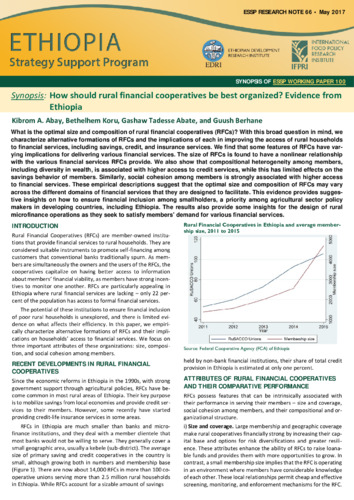
Brief
Synopsis: How should rural financial cooperatives be best organized? Evidence from Ethiopia
2017Abay, Kibrom A.; Koru, Bethlehem; Abate, Gashaw T.; Berhane, Guush
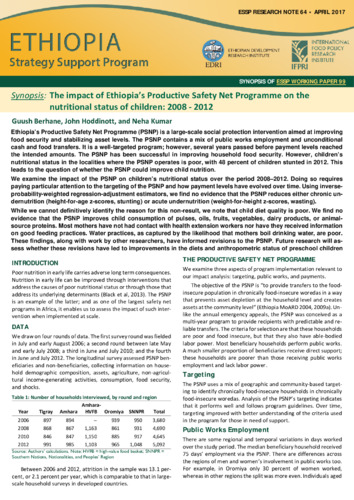
Brief
Synopsis: The impact of Ethiopia’s Productive Safety Net Programme on the nutritional status of children: 2008–2012
2017Berhane, Guush; Hoddinott, John F.; Kumar, Neha
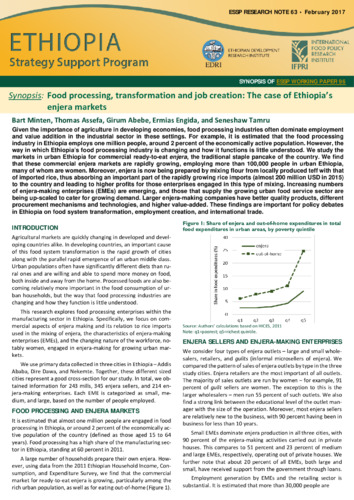
Brief
The case of Ethiopia’s enjera markets: Synopsis: Food processing, transformation and job creation
2017Minten, Bart; Assefa, Thomas; Abebe, Girum; Tamru, Seneshaw; Engida, Ermias
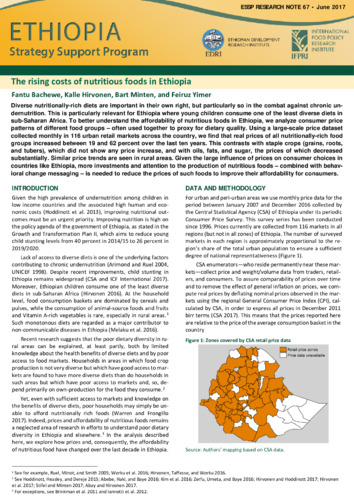
Brief
The rising costs of nutritious foods in Ethiopia
2017Bachewe, Fantu Nisrane; Hirvonen, Kalle; Minten, Bart; Yimer, Feiruz
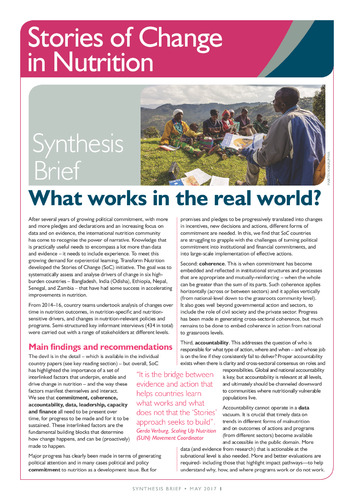
Brief
What works in the real world? Synthesis brief
2017Gillespie, Stuart

Brief
Synopsis: The Sustainable Land Management Program in the Ethiopian highlands: An evaluation of its impact on crop production
2017Schmidt, Emily; Tadesse, Fanaye
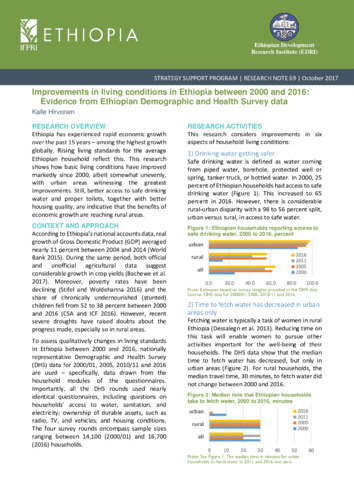
Brief
Improvements in living conditions in Ethiopia between 2000 and 2016: Evidence from Ethiopian Demographic and Health Survey data
2017Hirvonen, Kalle
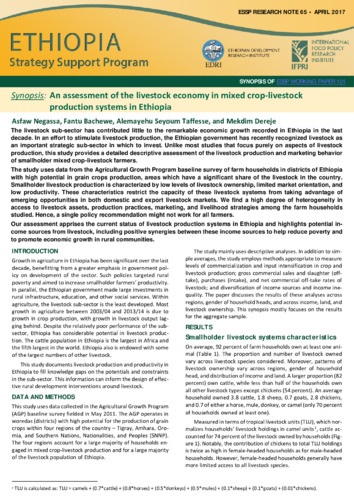
Brief
Synopsis: An assessment of the livestock economy in mixed crop-livestock production systems in Ethiopia
2017Negassa, Asfaw; Bachewe, Fantu Nisrane; Taffesse, Alemayehu Seyoum; Dereje, Mekdim
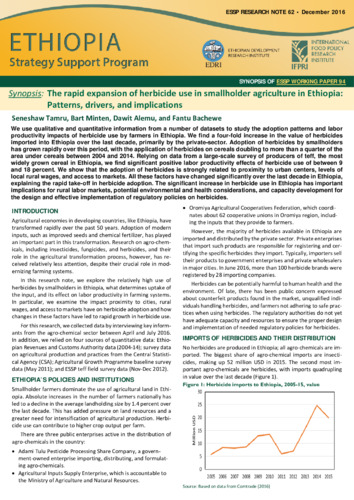
Brief
Synopsis: The rapid expansion of herbicide use in smallholder agriculture in Ethiopia: Patterns, drivers, and implications
2016Tamru, Seneshaw; Minten, Bart; Alemu, Dawit; Bachewe, Fantu Nisrane
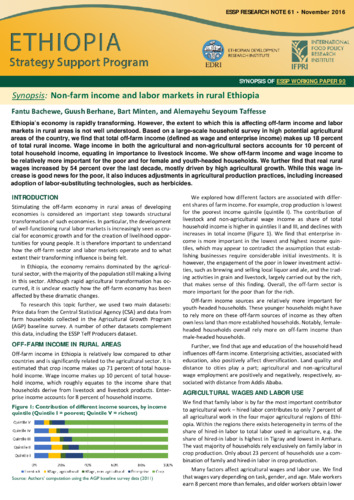
Brief
Synopsis: Non-farm income and labor markets in rural Ethiopia
2016Bachewe, Fantu Nisrane; Berhane, Guush; Minten, Bart; Taffesse, Alemayehu Seyoum
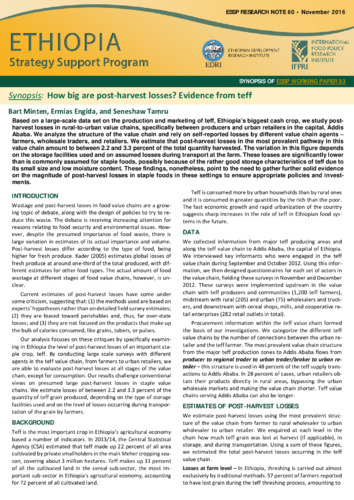
Brief
Synopsis: How big are post-harvest losses? Evidence from teff
2016Minten, Bart; Engida, Ermias; Tamru, Seneshaw
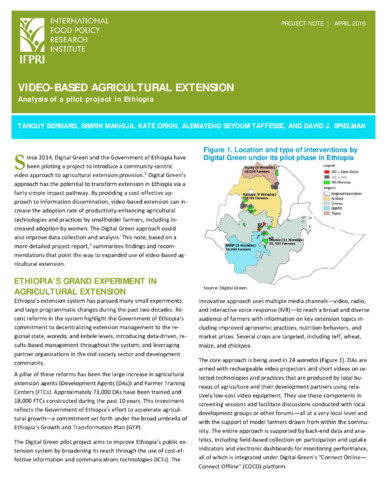
Brief
Video-based agricultural extension: Analysis of a pilot project in Ethiopia
2016Bernard, Tanguy; Makhija, Simrin; Orkin, Kate; Taffesse, Alemayehu Seyoum; Spielman, David J.
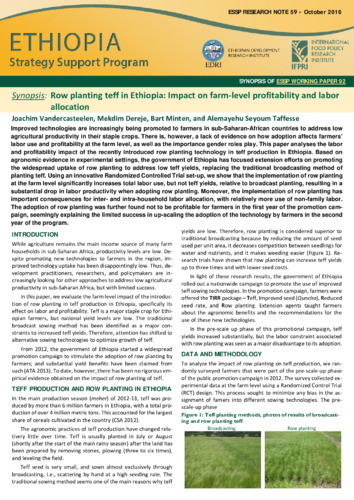
Brief
Synopsis: Row planting teff in Ethiopia: Impact on farm-level profitability and labor allocation
2016Vandercasteelen, Joachim; Dereje, Mekdim; Minten, Bart; Taffesse, Alemayehu Seyoum
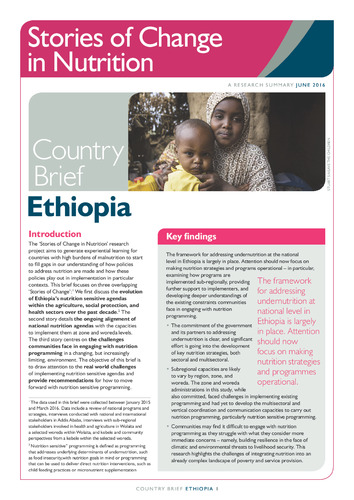
Brief
Ethiopia country brief
2016Warren, Andrea
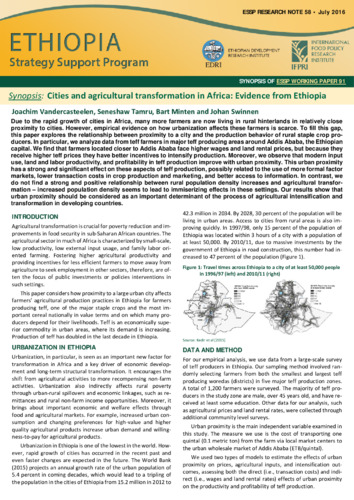
Brief
Synopsis: Cities and agricultural transformation in Africa: Evidence from Ethiopia
2016Vandercasteelen, Joachim; Tamru, Seneshaw; Minten, Bart; Swinnen, Johan
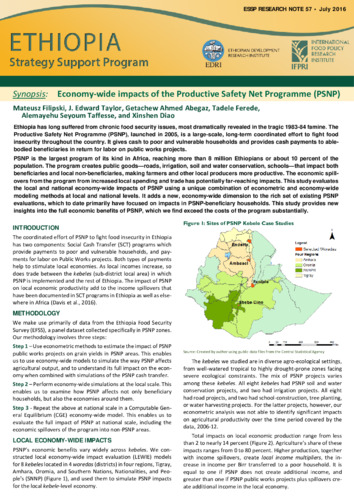
Brief
Synopsis: Economy-wide impacts of the Productive Safety Net Programme (PSNP)
2016Filipski, Mateusz J.; Taylor, J. Edward; Abegaz, Getachew Ahmed; Ferede, Tadele; Taffesse, Alemayehu Seyoum; Diao, Xinshen
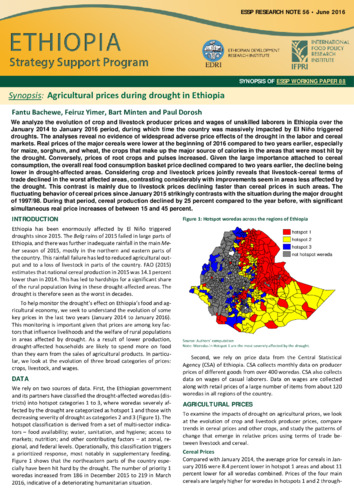
Brief
Synopsis: Agricultural prices during drought in Ethiopia
2016Bachewe, Fantu Nisrane; Yimer, Feiruz; Minten, Bart; Dorosh, Paul A.
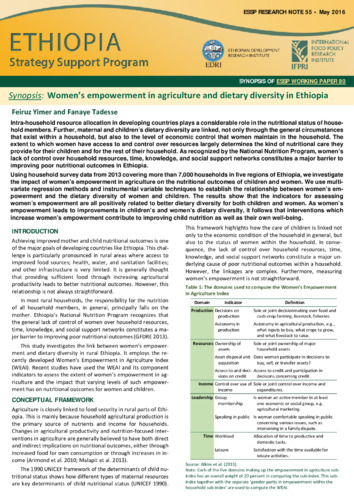
Brief
Synopsis: Women’s empowerment in agriculture and dietary diversity in Ethiopia
2016Yimer, Feiruz; Tadesse, Fanaye
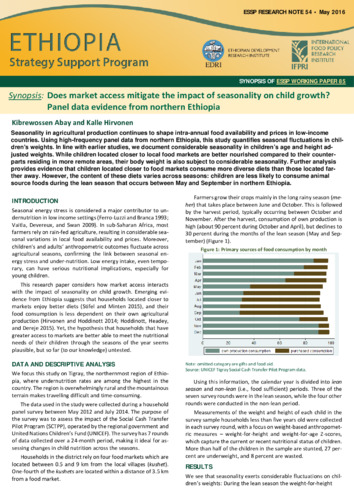
Brief
Synopsis: Does market access mitigate the impact of seasonality on child growth? Panel data evidence from northern Ethiopia
2016Abay, Kibrewossen; Hirvonen, Kalle
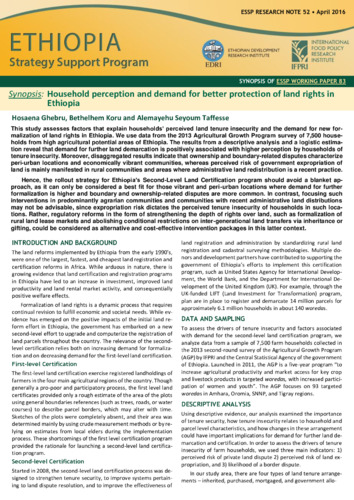
Brief
Synopsis: Household perception and demand for better protection of land rights in Ethiopia
2016Ghebru, Hosaena; Koru, Bethlehem; Taffesse, Alemayehu Seyoum
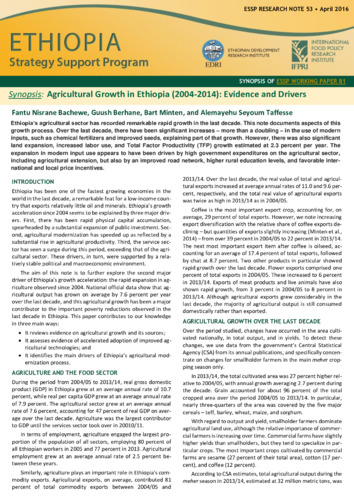
Brief
Synopsis: Agricultural growth in Ethiopia (2004-2014): Evidence and drivers
2016Bachewe, Fantu Nisrane; Berhane, Guush; Minten, Bart; Taffesse, Alemayehu Seyoum

Brief
Synopsis: Market access, welfare, and nutrition: Evidence from Ethiopia
2016Stifel, David; Minten, Bart
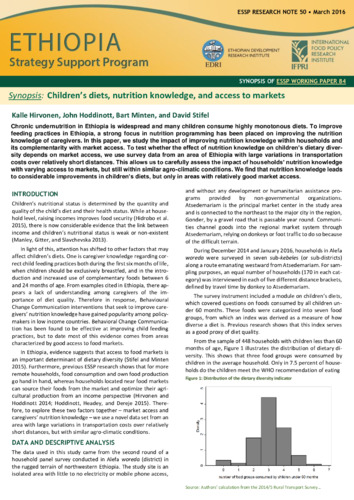
Brief
Synopsis: Children’s diets, nutrition knowledge, and access to markets
2016Hirvonen, Kalle; Hoddinott, John F.; Minten, Bart; Stifel, David
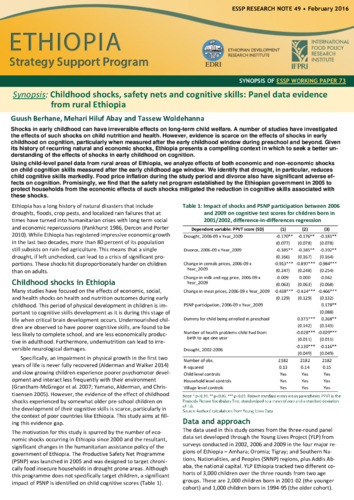
Brief
Synopsis, Childhood shocks, safety nets and cognitive skills: Panel data evidence from rural Ethiopia
2016Berhane, Guush; Abay, Mehari Hiluf; Woldehanna, Tassew
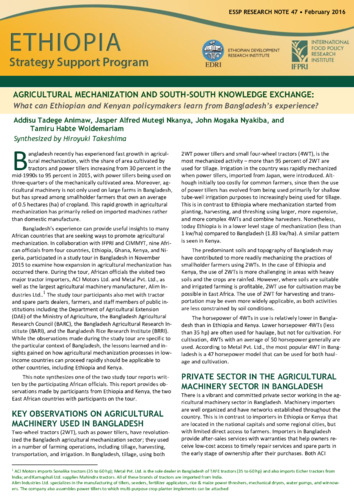
Brief
Agricultural mechanization and south-south knowledge exchange: What can Ethiopian and Kenyan policymakers learn from Bangladesh’s experience?
2016Animaw, Addisu Tadege; Nkanya, Jasper Alfred Mutegi; Nyakiba, John Mogaka; Woldemariam, Tamiru Habte; Takeshima, Hiroyuki
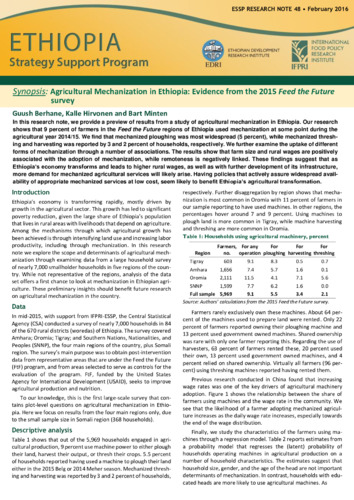
Brief
Synopsis, Agricultural mechanization in Ethiopia: Evidence from the 2015 Feed the Future survey
2016Berhane, Guush; Hirvonen, Kalle; Minten, Bart
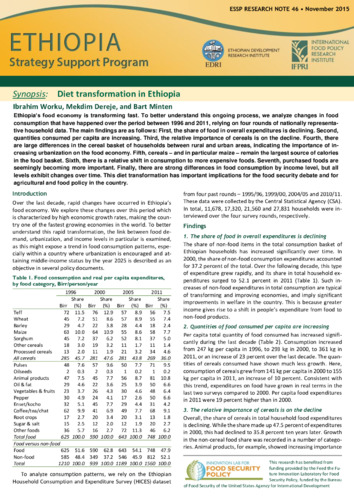
Brief
Synopsis, Diet transformation in Ethiopia
2015Worku, Ibrahim; Dereje, Mekdim; Minten, Bart
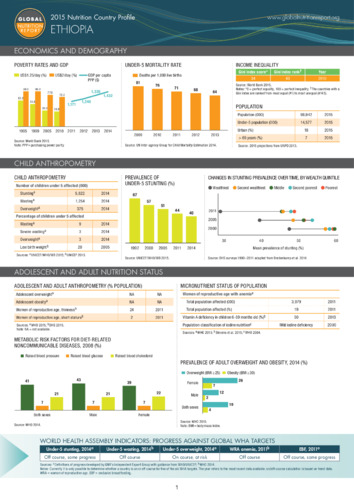
Brief
2015 Nutrition country profile: Ethiopia
2015International Food Policy Research Institute
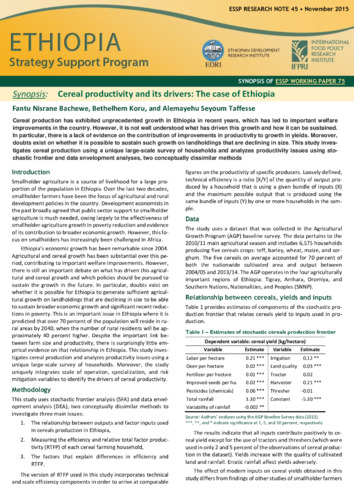
Brief
Synopsis, Cereal productivity and its drivers: The case of Ethiopia
2015Bachewe, Fantu Nisrane; Koru, Bethlehem; Taffesse, Alemayehu Seyoum
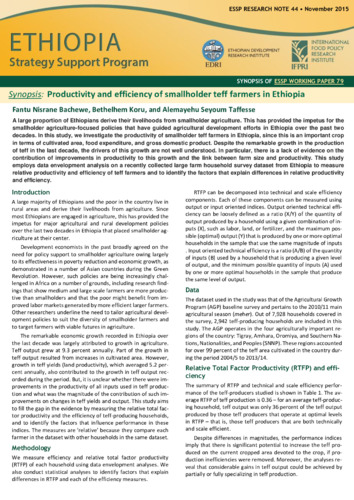
Brief
Synopsis, Productivity and efficiency of smallholder teff farmers in Ethiopia
2015Bachewe, Fantu Nisrane; Koru, Bethlehem; Taffesse, Alemayehu Seyoum
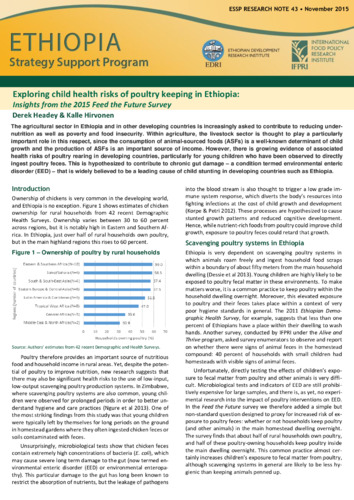
Brief
Exploring child health risks of poultry keeping in Ethiopia: Insights from the 2015 Feed the Future Survey
2015Headey, Derek D.; Hirvonen, Kalle
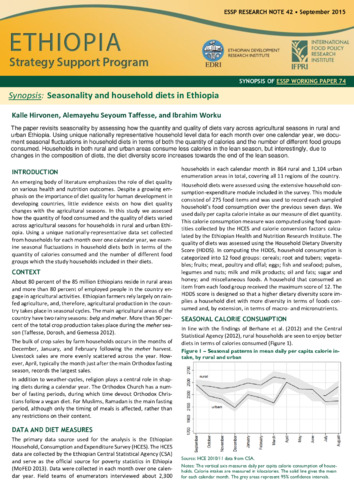
Brief
Synopsis: Seasonality and household diets in Ethiopia
2015Hirvonen, Kalle; Taffesse, Alemayehu Seyoum; Worku, Ibrahim
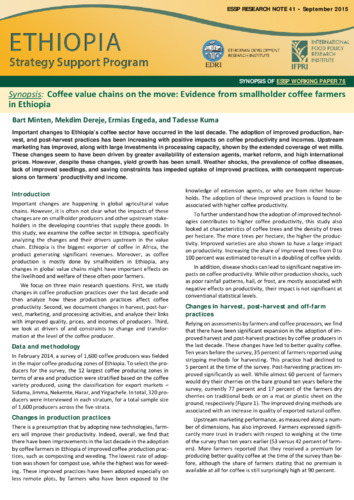
Brief
Synopsis: Coffee value chains on the move: Evidence from smallholder coffee farmers in Ethiopia
2015Minten, Bart; Dereje, Mekdim; Engida, Ermias; Kuma, Tadesse